Tålmodig jägare
En del djur hittar sin mat genom att söka upp och jaga sitt byte. Andra djur ligger hellre i bakhåll och väntar. Vissa kan klara sig i flera veckor innan det kommer ett djur de kan äta upp. Djur som ligger i bakhåll har många olika strategier för att det ska fungera.
Orkidébönsyrsan sitter still på en orkidé och väntar på sitt byte.
Bild: Luc-Viatour-CC-BY-SA
Fluga som fastnat i nätet hos en spindel - en annan tålmodig jägare.
Bild: Colourbox
En saltvattenskrokodil lurpassar i vattnet.
Bild: Bernard-Dupont-CC-BY-SA
Myrlejonlarven gräver fallgropar där bytesdjuren kan trilla rakt ner i larvens gap.
Bild: Bernt-Rostad-CC-BY
Snabb attack och fällor
Ett djur som jagar genom att ligga i bakhåll använder väldigt lite energi till att röra sig. Då kan djuret istället lägga energi på att vara väldigt, väldigt snabb när det väl kommer förbi ett bytesdjur. Gabonhuggormar har en blixtsnabb attack.
Andra djur som jagar i bakhåll är till exempel bönsyrsor, många spindlar och krokodiler. Vissa gillrar en fälla. Spindlar bygger nät, andra djur kan gräva ett hål som bytesdjur trillar ned i.
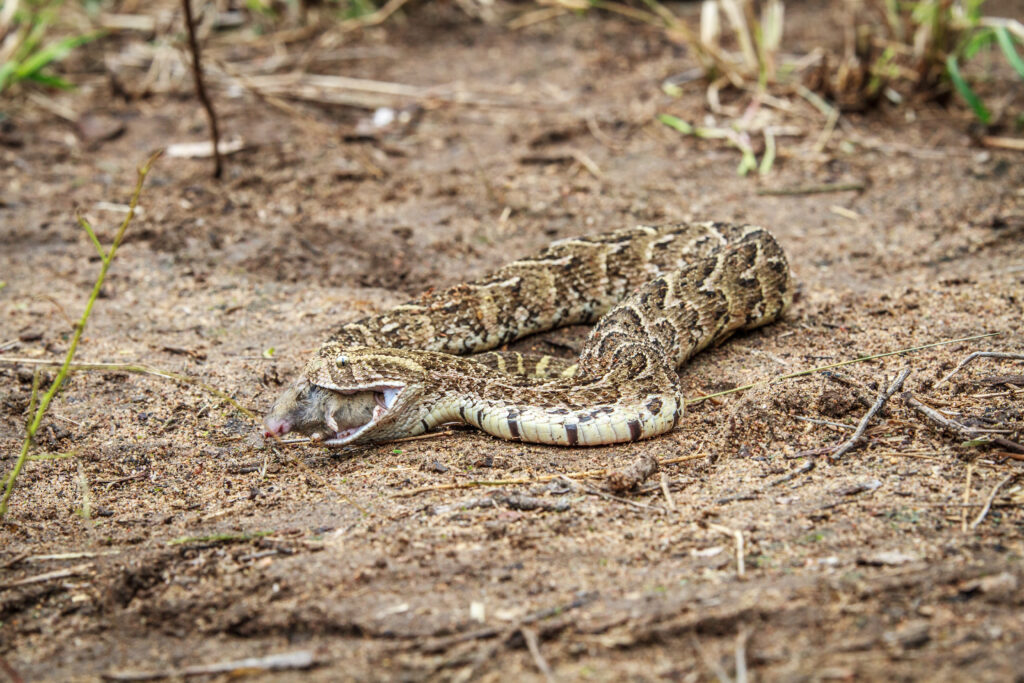
Bild: Colourbox
Döda med gift
Den afrikanska pufformen och gabonhuggormen är nära släkt och tillhör bland de farligaste ormarna i världen. Det är för att de har ett mycket starkt gift. Ett bett från någon av dessa ormar kan enkelt döda en människa. Dessutom har de, precis som flera andra arter i samma släkte, otroligt kraftfulla huggtänder.
När en sådan orm hittar ett byte gör de ett extremt snabbt utfall och hugger med sina långa vassa tänder i bytesdjuret. Genom kanaler i tänderna pumpar ormen in giftet i muskeln på bytesdjuret. Vissa giftormar släpper sedan direkt och låter bytesdjuret komma loss. De söker sedan upp djuret när det försvagats eller dött. Gabonhuggormen, däremot, biter sig fast i sitt byte och släpper inte. Snart börjar giftet verka och ormen kan svälja sitt byte.

Gabonhuggorm
Bitis rhinoceros
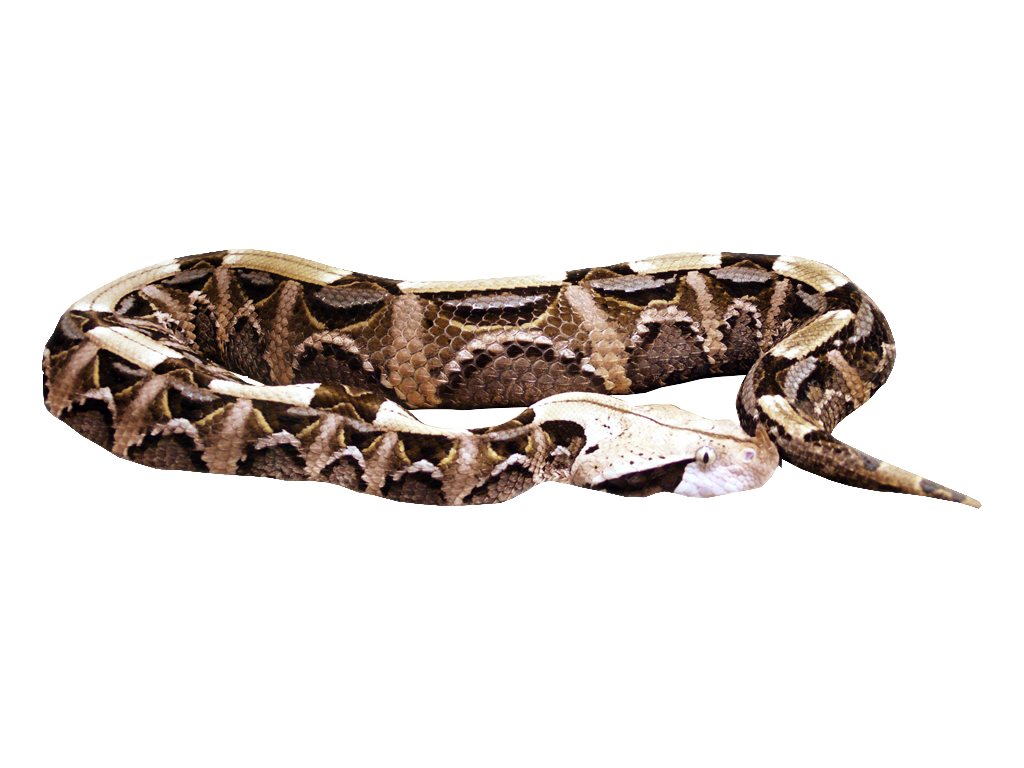
Världens längsta huggtänder
Gabonhuggormen är världens största huggorm. Den har också de längsta huggtänderna, upp till 5 cm. Dessutom har den störst mängd gift av alla giftormar.

Bild: Brimac-The-2nd-CC-BY
Välkamouflerad
Kan du se ormen? Den är svår att upptäcka. Titta efter huvudet som är format som ett löv. Gabonhuggormen lever på marken och är aktiv på natten. På dagen vilar den mest.
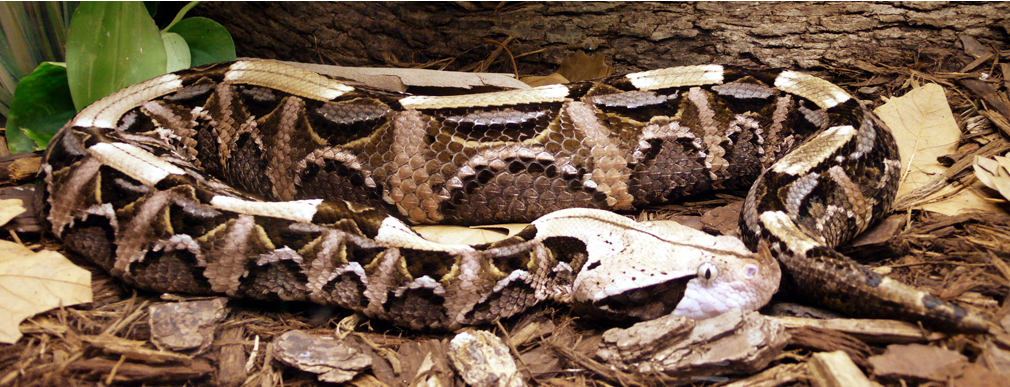
Utbredningsområde i världen
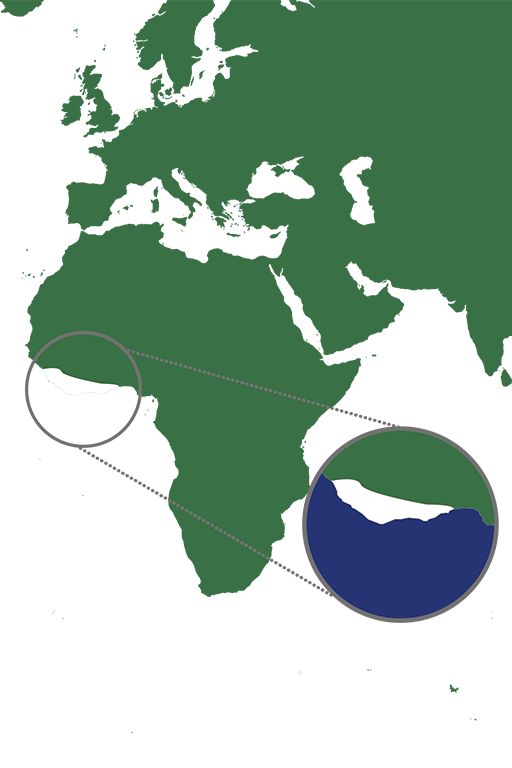
Afrika söder
om Sahara.
Vit markering = Utbredningsområde.
Hotstatus enligt Rödlistan

Reglerad inom handel
CITES: Ej listad.
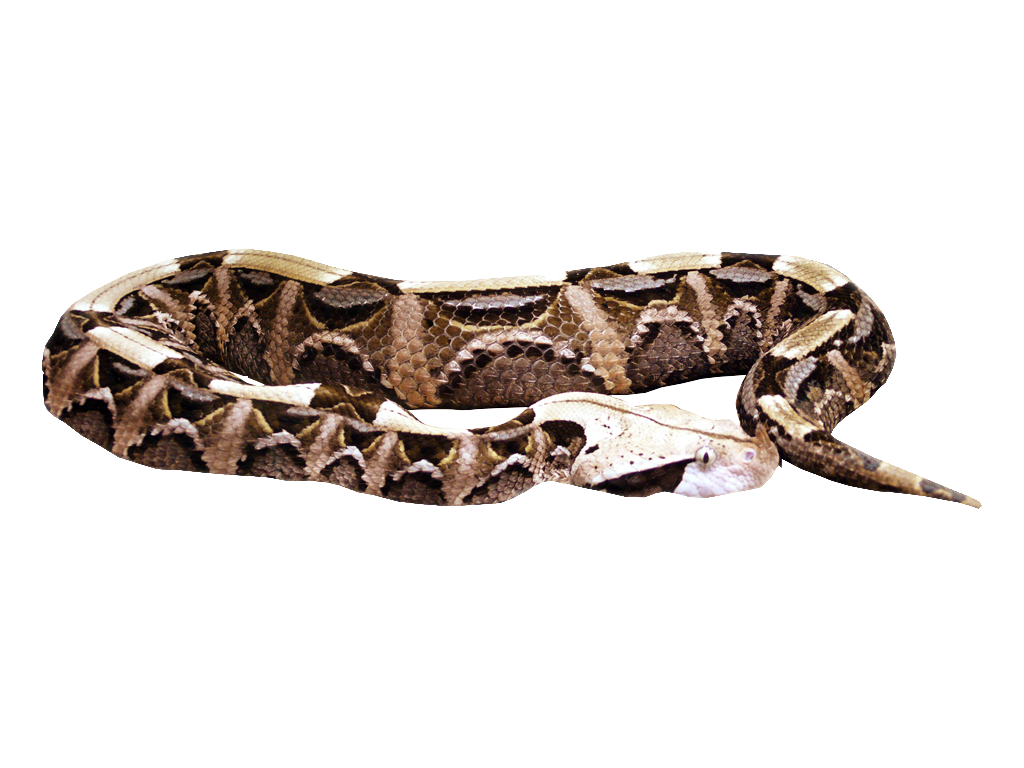
Vad är Rödlistan?
Rödlistning är ett sätt att bedöma om olika djur- och växtarter är utrotningshotade utifrån kriterier som hur många djur eller växter som finns av arten och hur utbredda de är. En nationell rödlistning bedömer artens risk att dö ut inom ett lands gränser. Den internationella rödlistningen bedömer artens risk att dö ut över hela jorden.
Läs mer

Om rödlistning i Sverige: Artdatabanken, www.artdatabanken.se
Om rödlistning i världen: International Union for Conservation of Nature, IUCN, www.iucn.org

Vad är CITES?
För att bekämpa olaglig handel med djur och växter finns en internationell överenskommelse om handel, som heter CITES. CITES innebär att utrotningshotade djur och växter inte får köpas eller säljas mellan olika länder utan tillstånd.
CITES klassar olika arter i olika kategorier (som kallas Appendix I, II och III) beroende på hur hotad arten är. Ju större hotet från handeln är desto högre skydd. Inom EU finns ytterligare skydd för arter i CITES. EU:s egen klassning har fyra steg: A-D.

Bild: Steve-Hillebrand
Förbjudet att handla med viltfångade arter
Högst skydd mot handel har de arter som är inom kategori A och B. Här gäller oftast att handel mellan EU och övriga världen är förbjuden utan tillstånd. Arter som är CITES A eller B-klassade får inte heller köpas eller säljas inom EU om det inte kan bevisas att de har lagligt ursprung och inte fångats i det vilda.
Att använda växter eller djur för att tillverka souvenirer och annat är också förbjudet. Den som bryter mot reglerna kan dömas till böter eller fängelse.
Kontrollera spridning av arter

Arter som är CITES C-klassade är utrotningshotade i ett visst land men inte nödvändigtvis i hela världen. CITES D-klassning betyder att en art importeras i så stort antal att de behöver regleras för att inte riskera att sprida sig okontrollerat där de inte hör hemma.

Patient hunter
Some animals find their food by seeking out and hunting their prey. Other animals prefer to lie in ambush and wait. Some can last for several weeks before an animal comes along that they can eat. Animals that ambush their prey use many different strategies.
The Orchid Mantis patiently waits for its prey on an orchid flower.
Photo: Luc-Viatour-CC-BY-SA
A fly caught in the net of a spider - another patient hunter.
Photo: Colourbox
A Saltwater Crocodile lies in ambush in the water.
Photo: Bernard-Dupont-CC-BY-SA
The Antlion larvae digs pits where prey can fall straight into the mouth of the larvae.
Photo: Bernt-Rostad-CC-BY
Quick attacks and traps
An animal that hunts by lying in wait uses very little energy to move. It can then use that energy to be very, very fast when a prey animal does pass by. The Gaboon viper has a lightning-quick attack.
Other animals that ambush their prey include praying mantises, many spiders, and crocodiles. Some of them like using traps. Spiders spin webs; other animals can dig a hole that the prey animal falls into.

Photo: Colourbox
Kills with venom
The puff adder and Gaboon viper are close relatives and are among the most dangerous snakes in the world. This is because they have a very strong venom. A bite from one of these snakes can easily kill a human. Just like a number of other species in the same family, they also have incredibly powerful fangs.
When such a snake finds a prey animal, it attacks extremely quickly and sinks its long fangs in its prey. Through channels in its fangs, the snake pumps the venom into the muscle of its prey. Some venomous snakes then let go immediately and release the prey. They then seek out the animal again after it has been weakened or died. In contrast, the Gaboon viper bites into its prey and doesn’t let go. The venom soon starts working and the viper can swallow its prey.

Gaboon Viper
Bitis rhinoceros

The longest fangs in the world
The Gaboon viper is the world’s biggest viper. It also has the longest fangs, up to 5 cm. It also has the most venom of all venomous snakes.

Photo: Brimac-The-2nd-CC-BY
Well camouflaged
Can you see the snake? It is hard to find. Look for its head, which is shaped like a leaf. The Gaboon viper lives on the ground and is active at night. During the day it mostly rests.

Distribution worldwide

Africa south
of the Sahara.
White marking = Distribution
Threat based on the Red List

Reglerad inom handel
CITES: Not listed.

What is the Red List?
The Red List is a way to assess whether different animal and plant species are at risk of extinction based on criteria such as how many animals or plants of a species exist and how widely distributed they are. A national Red List assesses a species’ risk of dying out within national borders. The international Red List assesses a species’ risk of dying out worldwide.
Read more

About the Red List in Sweden: The Swedish Species Information Centre (Artdatabanken), www.artdatabanken.se/en/
About the Red List worldwide: The International Union for Conservation of Nature (IUCN), www.iucn.org

What is CITES?
CITES (the Convention on International Trade in Endangered Species of Wild Fauna and Flora) is a treaty that makes it illegal to buy or sell animals and plants that are at risk of extinction between countries without a permit.
CITES classifies species into different categories (called Appendix I, II and III) depending on how endangered each species is. In addition, the more the species is threatened by international trade, the higher its level of protection. Within the EU, CITES-listed species are further classified and protected by the EU’s own classification system. This has four Annexes, from A to D.

Photo: Steve-Hillebrand
Ban on trading wild-caught species
The highest protection against trade is given to CITES-listed species included in the EU’s Annexes A and B. Usually this means that trade between the EU and the rest of the world is illegal without a permit. There is also a ban on trading these species within the EU unless it can be proved that they have a lawful origin and were not caught in the wild.
It is also forbidden to use plants or animals to make souvenirs etc. Anyone who breaks these regulations can be fined or imprisoned.
Controlling the spread of species

CITES-listed species that are in the EU’s Annex C are classified as endangered in at least one country but not necessarily in the whole world. An Annex D classification means that individual members of a species may be imported to the extent that they do not need to be regulated to avoid any risk of them spreading uncontrollably where they do not belong.
